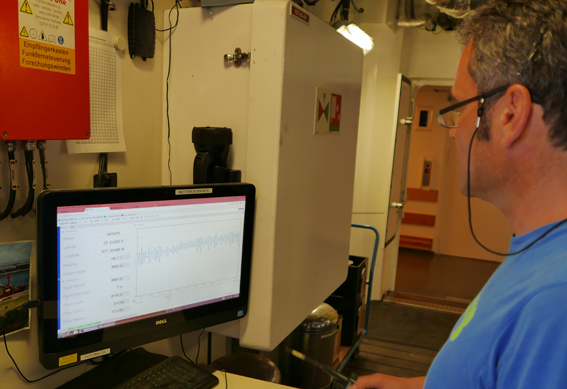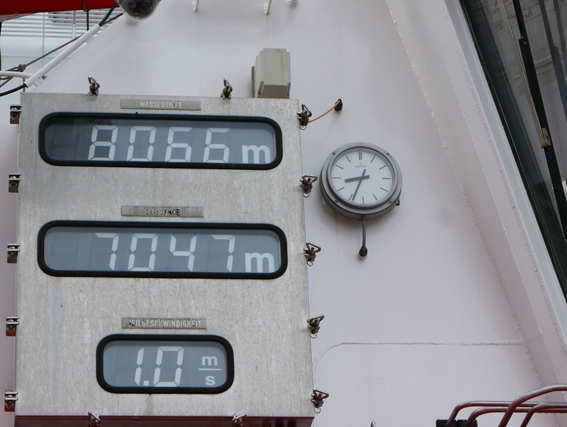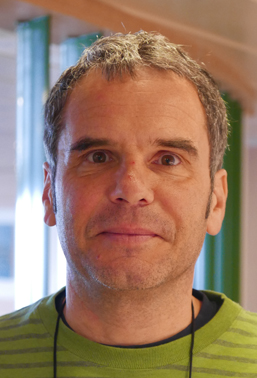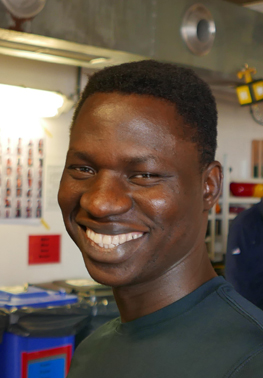- Press Office
- Blogs and More
- Secrets of the seafloor - Blogpost 5 from RV SONNE, March 14, 2018
Secrets of the seafloor - Blogpost 5 from RV SONNE, March 14, 2018
On Board RV SONNE, Chile
23 degrees 21.78 S, 071 degrees 20.6 W
Wednesday, March 14, 2018
At first glance, pictures of the seabed seem rather boring. What looks like dark gray mud, however, harbors the collected remains of centuries past. Everything that has ever lived in the sea leaves lasting traces. Additionally to biological leftovers, there is dust transported through the air from land, coastal erosion and the matter transported by rivers into the sea.
Matthias Zabel and his team from MARUM of the University of Bremen are mainly interested in the biological processes in the sediments of the Atacama deep-sea trench. They use two well-established sampling methods to study the seabed.
The multicorer for the upper 40 centimeters
With the multicorer, Matthias Zabels team can take twelve sediment cores at once. These cover the upper sediment layers: starting from the bottom water layer and the upper sediment layer, they reach a depth of 40 centimeters. This sounds like an easy task, but definitely it is not.
Matthias Zabel explains the problem: "With a winch we lower the multicorer on a steel cable to the seafloor. When almost there, it is important that the winch driver reduces the speed so that there will be a soft landing. Today we are working at a water depth of 8066 meters. It took more than two hours just to reach this depth. You have to keep in mind that at that depth, the device is slightly drifting off. Any ship movement affects the cable movements. Therefore, for the last few meters, you have to be very careful. As a rule, I have a close look at the cable tension displayed on a computer screen. When the multicorer hits the ground, this tension suddenly decreases: this is the landing. Now it is like hit and run, you have to start the winch immediately so that the device does not bounce up and down like a yo-yo. Upon my call via radio, the winch driver drives the winch up again immediately. This cooperation works wonderfully. I'm thrilled, I have never had so many good cores on an expedition. "
The gravity corer for larger sediment depths
The centerpiece of the heavy-duty gravity corer is a 10 meters long steel pipe shielding a plastic pipe. The gravity corer is connected to a winch cable on deck of RV Sonne. Just by brute force, the total mass of 1.5 tons ensures that the corer is rammed vertically into the seabed. When this is done, the core has to be pulled out carefully. On pulling up a valve on top of the corer mechanically closes, in addition a so-called core catcher at the bottom prevents the core to slip back out of the pipe. Back on deck, the researchers cut the core into 1-meter-long segments, and immediately transport them to the cooling chamber at 4 degrees. "This is a world premiere”, says Zabel. “On this expedition, we were able to pull the first long cores out of the Atacama deep-sea trench."
Landslides result in graded stratification
In the next step, Zabels team drills small holes laterally into the cores every 15 centimeters. Through these tiny holes they collect the pore water using special vacuum syringes (rhizons). After analyzing the substances dissolved in the pore water, it is possible to determine which biogeochemical processes take place in the deep deposits. Also the depositional history can be derived. Back home in the laboratories an exact age determination is carried out.
Matthias Zabel explains: "The large variations in the pore water data of one individual core suggest that the sediments are not old and their deposition was interrupted again and again. The Atacama Trench is located directly on an active subduction zone. It was created by the Pacific Nazca plate sliding slowly under the South American plate. That's happening at roughly the same speed as our fingernails grow. Thus, older sediment disappears continuously with the subducting plate. When the built-up tectonic stress relieves, it is rumbling. Then the deposits can slip off the eastern trench slope into the trench. We see that very well on the graded layers in our cores. In our last core with a length of four meters, we had at least three layers where coarser particles from the mainland dominate." The entries from land can be well distinguished from input from the sea.

Iron, potassium, aluminum and silicon are terrigenous, i.e. of land-based origin. Marine components are carbonates and most of the organic material. The latter originates from the food web, the basis of which is the biomass of photosynthetic microorganisms (phytoplankton) in the upper light-flooded parts of the water column.
Microorganisms decompose almost everything
The northward-setting Humboldt Current along the coast of Chile causes nutrient-rich deep water to rise. This is important for the food web. Only if sufficient nutrients such as ammonium, nitrate, phosphate and metal ions such as iron are available, the photosynthetic algae can multiply and serve as a food source for others. When they die, they sink to the bottom of the sea, decomposing into flaky lumps as they descend. Below, these remnants form part of the sediment. But that's not the end of their story, because on and in the seabed other microorganisms draw energy from the remnants. Over the centuries the sediment layer grows steadily.
From above, new debris and particles continuously cover the older layers. In the uppermost layers, certain microorganisms use the abundant oxygen penetrating from the water column into the sediment. Oxygen is an effective oxidizer. Below, the microorganisms rely on alternatives such as nitrate, manganese, iron and sulfate.
By examining the depth profile of these substances, parameters can be calculated that provide information about the biological activities in the sediment. As a rule of thumb, the steeper the drop in the profile, the more active are the microorganisms. Finally, only about 0.1% of the biomass that rained down from above is stored in the sediments.
The Atacama Trench: From the west, the Nazca plate slides under the South American plate. Through tectonically triggered landslides sand from the mainland ends up in the trench (left). This can be seen in the depth profiles of the gravity cores (see insert). The eastern trench side benefits from the algae blooms. This is typical for upwelling areas. Here, nutrient-rich deep water rises and boosts biomass production. The diagram on the right shows the unusually steep sediment profiles of oxygen and other substances in the sediment. These testify to the high bioactivity of the trench.
Part of Matthias Zabels team
Specific questions addressed during this cruise are:
- What are the sedimentary processes providing food for the hadal community in the Atacama Trench?
- How do abundance, diversity and community structure of microorganisms, meio- and macrofauna in the Atacama Trench differ from those in less productive trenches and nearby abyssal and shelf sites?
- What are the general biogeochemical characteristics of the surface and deep sediment and water column in the eutrophic Atacama Trench?
- Which mineralization pathways are responsible for organic matter breakdown in the eutrophic Atacama Trench?
- How efficient are microbial communities operating at extreme hydrostatic pressures in mineralizing organic material as compared to their shallower counterparts? And to what extent do specialized, yet unknown extremophile microbial communities mediate these processes?
Further information
More details about the project from the University of Southern Denmark.
More pictures related to the project.
Ronnie N Glud at Danmarks Radio (in Danish)
RV SONNE is a modern German research vessel sailing mainly in the Pacific Ocean.
More information about the ship here.






